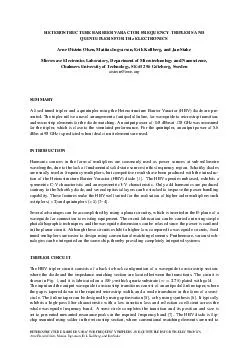PPT-BASIC ELECTRONICS
Author : stefany-barnette | Published Date : 2016-09-08
Transistor Audio Power Amplifiers Introduction A transistor amplifier that raises the power level of the signals that have audio range is known as transistor audio
Presentation Embed Code
Download Presentation
Download Presentation The PPT/PDF document "BASIC ELECTRONICS" is the property of its rightful owner. Permission is granted to download and print the materials on this website for personal, non-commercial use only, and to display it on your personal computer provided you do not modify the materials and that you retain all copyright notices contained in the materials. By downloading content from our website, you accept the terms of this agreement.
BASIC ELECTRONICS: Transcript
Transistor Audio Power Amplifiers Introduction A transistor amplifier that raises the power level of the signals that have audio range is known as transistor audio power amplifier In general the last stage of a multistage amplifier the power stage The power amplifier differs from all the previous stages in that here a concentrated effort is made to obtain maximum output power A transistor that is suitable for power amplification is generally called a power transistor It differs from other transistors mostly in size it is considerably larger to provide for handling the great amount of power. separation sorting filtering 002002013 Moulding injection moulding extrusion sintering 002002014 Surface treatment painting galvano polishing CVD PVD 002003 Process control and logistics 002004 Plant Design and Maintenance 002005 PackagingHandling 0 The Company is looking forward to recruit high caliber and talented professional on contractual basis for two years which is further extendable on performance basis for one more year only n the basis of exemplary performance during the contractual p 7 311 332 285 Internet Advertising 261 277 301 357 Email Advertising 253 249 293 359 Direct Mail 224 226 235 204 Magazines 197 184 225 268 Cable 189 205 222 200 Newspaper 189 186 222 170 Radio 175 188 181 134 Social Media Facebook Twitter etc 142 164 Signs of change are everywhere Consider the choice of keynote speakers at the 2001 Consumer Electronics Show the roster of businesses highlighted in ZDNetcoms Ten hottest products at CES 1 or the chair of the committee charged with adding a wire les All other products and company names referred to herein may be trademarks or regis tered trademarks of their respective companies or mark holders Copyright 2010 Tyco Electronics Corporation brPage 2br M E A N T I M E B E T W E E N F A I L U R E M T org SUMMARY A 64257xed tuned tripler and a quintupler using the Heterostructure Barrier Varactor HBV diode are pre sented The tripler utilise a novel arrangement of antipodal 64257nline for waveguide to microstrip transition and microstrip elements f Joint Waste and Procurement TSN. 11. th. March 2015. Queen Margaret University. Agenda. 10-00 Registration and refreshments. 10-15 Welcome and Introductions. 10-30 Electronics and the Circular Economy in HFE. Achievements Report. November 8, 2016 . Department of Industrial Policy and Promotion . . MAKE . IN INDIA. Ministry of Electronics & Information Technology. Electronics & IT Sector. The Government is driving forward . Week 0. ECE 1750 - Power Electronics Conversion Theory. Tuesdays and Thursdays from 2:30 pm to 3:45 pm. Professor: Alexis . Kwasinski. (. Benedum. Hall 1229, akwasins@pitt.edu, Ph: 412-383-6744).. © 2014 Project Lead The Way, Inc.. Digital Electronics. What are Digital Devices?. 2. A digital device contains an electrical circuit that uses discrete (exact) values in its design and function.. These discrete values are usually zero’s (0) and one’s (1).. INVESTMENT & TECHNOLOGY PROMOTION DIVISION. MINISTRY OF EXTERNAL AFFAIRS. NEW DELHI. Electronics. Indian Electronics System Design and Manufacturing (ESDM) industry is one of the fastest growing sectors in the country. . Electron is just a particle that can't be defined, but it has charge & tendency to flow. This nature of electron has made a separate section of study called electronics engineering .. Electronics is about study, designing & implementation of different components/circuits for various human necessities. . Casualty care A17. There are lots of things to remember when taking care of somebody.. Which . three. of these casualty care actions do you think are the most important?. Remain calm. Reassure the casualty. Jan . Kaplon. CERN, . Geneva . Outline. S. ilicon strip detectors for the High Luminosity LHC upgrade . Requirements and constraints. Basic architectures of the input stages. Examples of the channel architecture for ATLAS and CMS .
Download Document
Here is the link to download the presentation.
"BASIC ELECTRONICS"The content belongs to its owner. You may download and print it for personal use, without modification, and keep all copyright notices. By downloading, you agree to these terms.
Related Documents













